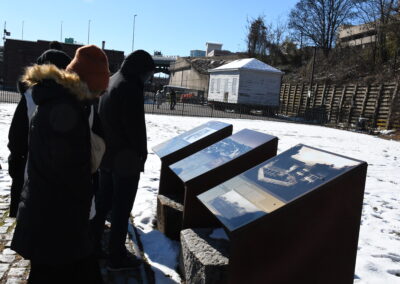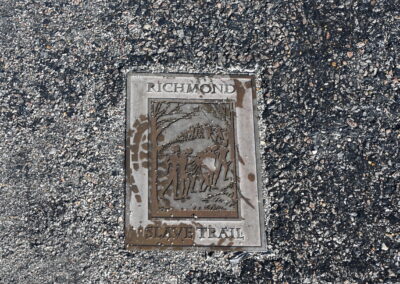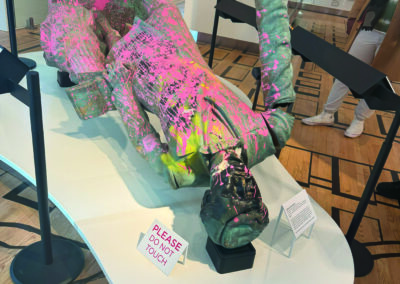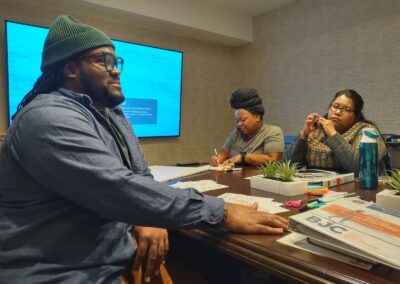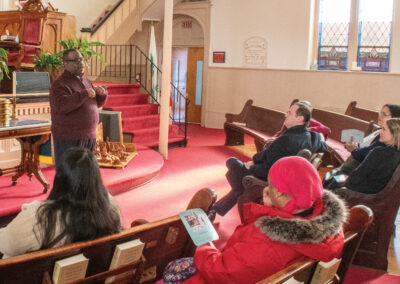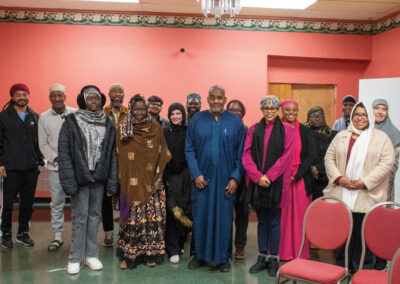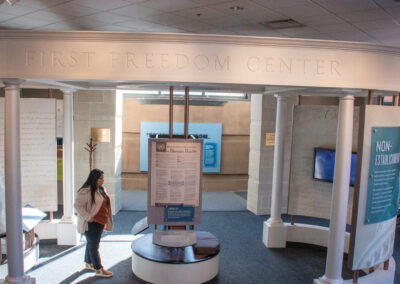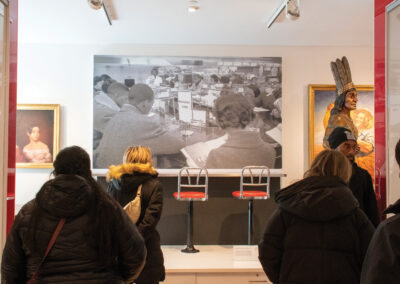Immersing ourselves in religious freedom
A new program expands the narrative and elevates key perspectives
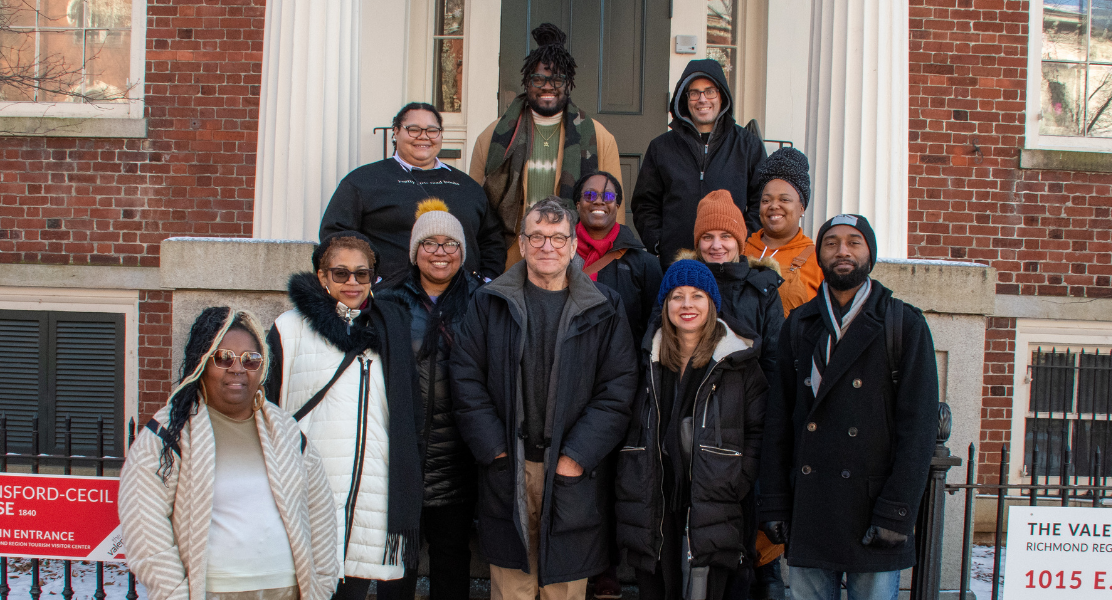
By Dr. Sabrina E. Dent
Director of the BJC Center for Faith, Justice and Reconciliation
“Powerful.” “Challenging.” “Reflective.” “Truth-telling.” “Necessary.”
That’s how participants described the Religious Freedom Immersion Experience, hosted by the BJC Center for Faith, Justice and Reconciliation in partnership with Wake Forest University School of Divinity. A diverse cohort of 12 individuals joined us January 6-10 in Richmond, Va., for this week-long educational initiative. Designed for seminary students and community members to critically engage with the contentious politics of race and religious freedom in American public life, our journey became an unforgettable lesson in history, community, pluralism and collective resistance.
Our multifaceted program allowed the Immersion Scholars to hear from academics, grassroots organizers, creatives, faith leaders and policy advocates, and we provided a broader story of religious freedom through guided tours and contextual learning at historic sites, combining theological, museum and civic education. In curating the experience, we paid particular attention to the ways power, violence, knowledge, ethics and pluralism form and frame the discourse across time and space.
Many of our plans changed as two snowstorms and a city-wide water crisis created tour cancellations, business closures and other obstacles. A year’s worth of planning had been reduced to hour-by-hour decisions to move the program forward while ensuring the safety and well-being of the participants. Nevertheless, we persisted as a community of people committed to learning while caring for one another.
You may wonder, why did we go to Richmond? It was the heart of the Confederacy during the period of the Civil War, and there are few better places to explore stories about race, religion and politics while seeking pathways to communal healing that reimagine faith freedom for all. Every location in Richmond was a clear reminder that symbols, language and diverse perspectives matter.
The group felt the gravity of history in our visits to the site of Lumpkin’s Jail, also known as the “Devil’s Half Acre.” It is a place where enslaved people were violently tortured and whipped into obedience, but the property itself eventually became Virginia Union University — a Historically Black College and University founded by American Baptist Home Mission Societies in 1865. It is now referred to as “God’s Half Acre” thanks to Mary Lumpkin, a formerly enslaved Black woman who sold the property to create a place of liberation where Blacks could learn to read and write.
We visited The Valentine Museum, which displays various artifacts and statues, including the vandalized statue of Jefferson Davis, the president of the Confederacy, that once stood tall in Richmond and was crafted by the museum’s namesake, Edward Valentine. The 1907 unveiling of the Davis statue contributed to the “Lost Cause” myth, an attempt to rewrite history through a counternarrative that the Confederacy was actually a noble and just cause instead of an act of treason against the United States. This birthed lies about the war being fought to protect the South’s rights instead of the profitable institution of slavery and that slavery benefited both the enslaved and oppressor. There was an eeriness to observing these exhibits in the very studio where several Confederate statues and racist caricatures were created.
Marrying the arts with the experience helped all of us reimagine a new way of elevating narratives about religious freedom. Dr. Kylan Pew, founder of The Black Seminarians Table, led us through an exercise known as “Graphic Facilitation” that uses visuals, colors and words to capture and interpret conversations, ideas and shared experiences. He inspired the cohort to creatively respond to the question, “What is your North Star?” Immersion Scholars designed badges that reflected their guiding principles or grounding place to illuminating a path toward liberation and human flourishing.
Our visit to the historic Gillfield Baptist Church in Petersburg, Va. — which also happens to be my hometown — elevated stories about Black clergy who engaged in collective resistance and advocacy to provide pathways to education for children in the segregated city. The ability to touch and browse the church’s archives made the stories about the congregation real and tangible beyond our imagination.
In contrast, our visit to Masjid Bilal in Richmond created opportunities for communal fellowship across differences and respect for other traditions. As we participated in Jumah, known as Friday prayer, we observed the beautiful mosaic of people practicing their faith in unity, and one participant shared how it created a new appreciation of the worship style of those practicing Islam. The existence of a predominantly Black Muslim presence in the Church Hill area of Richmond — where Patrick Henry spoke the words “Give me liberty or give me death” — reinforces Masjid Bilal’s commitment to equality and economic justice as issues that point to the intersection of advancing faith and freedom for all.
Cultivating appreciation for religious diversity is essential to achieving religious pluralism. It goes beyond acknowledgment to full engagement. Important to our discussions was illuminating the imbalance of power, including investigating how Black Muslims’ contributions to religious freedom are too often overlooked and asking ourselves, “Who speaks for God in public?”
This pilot program is not for the faint of heart, and this reflection only scratches the surface of what we experienced and learned together. This is ongoing, communal work that invites all people to engage in unapologetic truth-telling with a healthy curiosity and commitment to creating systemic change. As we brought together a diverse group, we found new communities, new revelations and new ways to deepen our commitment to religious freedom in listening to and uplifting all perspectives and experiences.
Dr. Sabrina E. Dent is the director of the BJC Center for Faith, Justice and Reconciliation.
Click here to read a companion article by Natalie Johnson-Abbot about the group’s experience at one site.
This article originally appeared in the spring 2025 edition of Report from the Capital. You can view it as a PDF or read a digital flip-through edition.
Presenters
Thank you to the instructors and facilitators during the Religious Freedom Immersion Experience:
Rahmah Abdulaleem, co-chair of the Religious Freedom Committee of the American Bar Association, Section of Civil Rights and Social Justice
Dr. Sabrina E. Dent, director of the BJC Center for Faith, Justice and Reconciliation
Imam Michael Abdul Hakim, teacher and leader at Masjid Bilal
Holly Hollman, general counsel and associate executive director of BJC
Rev. William H. Lamar IV, pastor of Metropolitan AME Church in Washington, D.C.
Leslie Luck, director of operations at Polegreen Church
Rev. Dr. George C.W. Lyons Jr., pastor of Gillfield Baptist Church
William “Bill” Martin, director of The Valentine Museum
Dr. Keisha McKenzie, public strategist and founder of McKenzie Consulting Group
Dr. Kylan Pew, creative and founder of The Black Seminarians Table
Rev. Dr. Nathan Taylor, executive director of the Virginia Baptist Historical Society and the Center for Baptist Heritage and Studies
Dr. Corey D.B. Walker, Dean, Wake Forest University School of Divinity and Wake Forest Professor of the Humanities

